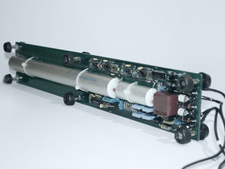How Does Such a Dose Rate (ODL) Probe Actually Work?
Many visitors to INFO KONRAD ask: How does such an ODL probe actually work? Should this question bother you, too, you are not compelled to pay us a visit at Chemnitzer Straße in order to get an answer. Because here you will not only get information about the level of the gamma dose rate in your surroundings but also how such a value is measured.

![]() ODL probe to measure the local dose rate
ODL probe to measure the local dose rate
Two Geiger-Mueller counters form the basis for the so-called ODL probe. The short tube is for a high gamma radiation level, the short tube for low doses. In both tubes there is a very thin wire with a diameter of less than 0.1 millimetres and an extinguishing gas. There is a high voltage on this wire so that an electrical field is generated between the wire and the outer shell. The arriving gamma radiation triggers an electron flashover and, thus, shortly generates an electric circuit. Via amplifiers, this electron flashover is converted into a signal. The extinguishing gas prevents that an electron flashover leads to a chain reaction and, thus, to wrong signals. The probe transmits the signal to a measurement transmitter. This must not be more than 150 metres away from the ODL probe. The measurement transmitter collects the various impulses and calculates minute, ten-minute, and two-hour-values of the local dose rate. Via the public telephone network, this data is transmitted to the respective measuring facility.
For each measuring point locally specific threshold values have been determined. In case they are exceeded, the measuring facility is automatically informed by the measuring point. In routine operation, the data are queried every 24 hours by each measuring facility, are evaluated and forwarded to IMIS.
State of 2008.11.24

